Book Review
Faster
by Kitty Kelley
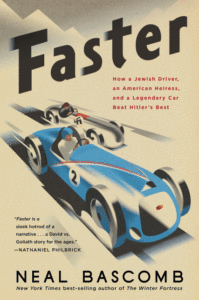 Racing in the European Grand Prix is like playing at Carnegie Hall, singing at the Met, or scaling Mt. Everest: it is the epitome of excellence, achieved by few, but thrilling thousands. Enzo Ferrari called it “this life of fearful joys.”
Racing in the European Grand Prix is like playing at Carnegie Hall, singing at the Met, or scaling Mt. Everest: it is the epitome of excellence, achieved by few, but thrilling thousands. Enzo Ferrari called it “this life of fearful joys.”
In 1938, the Grand Prix involved something more than two race-car drivers pitting themselves and their countries’ fastest automobiles against each other in a 100-lap race for superiority. In that particular year, the Grand Prix came down to:
Dreyfus vs. Caracciola
Delahaye vs. Mercedes
France vs. Germany
Good vs. Evil
In his newest book, Faster: How a Jewish Driver, an American Heiress, and a Legendary Car Beat Hitler’s Best, Neal Bascomb documents every detail of the contest between René Dreyfus, an American-financed French Jew, driving a Delahaye 145, and Rudi Caracciola, representing Germany in a Silver Arrow Mercedes. It was a titanic struggle between two nations that would lead one to humiliating defeat and the other to resounding victory.
Bascomb begins the story in 1933, when Adolf Hitler becomes chancellor of Germany and, as leader of the Third Reich, makes a major speech promoting Germany’s automobile industry, which he pronounces his “beloved child.” Hitler’s Silver Arrow Mercedes and their blond, blue-eyed drivers stood for more than sporting prowess.
“They represented the master race conquering the rest of the world,” Bascomb writes, showing that Daimler-Benz wasted no time ingratiating itself with the Fuhrer by immediately increasing production of military trucks, armored vehicles, aircraft frames, and tanks. Soon, Nazi propaganda trumpeted, “A Mercedes-Benz victory is a German victory.”
Within five years, Germany had annexed Austria. In March 1938, a month before the Grand Prix, Caracciola, Germany’s premier race-car driver, issued a public proclamation endorsing Hitler’s policies and supporting the Anschluss:
“We racing drivers are fighters for the world-class German automobile industry. Our victories are at the same time triumphs of German engineering and workmanship. The Fuhrer has once again given our factories the opportunity to build racing cars…their unique successes over the past four years represent a glorious symbol of the efforts of our leader.”
The glamour attached to the 1938 Grand Prix drew worldwide attention, and victory seemed assured for Germany as Dreyfus, unlike Caracciola, did not have a world-rated record of wins. In addition, the Delahaye 145 seemed like a plodding mule next to Daimler-Benz’s sleek thoroughbred.
But Dreyfus had the financial backing of American Lucy O’Reilly Schell, a rally driver herself. The only child of wealthy parents and “decidedly nouveau riche and unapologetic about it,” she inherited millions from her father’s fortunes in construction, factories, and real estate, and married a man who didn’t work. So she financed their shared passion for racing.
The wealth of detail in this book will rivet automobile enthusiasts; others might want to take a pass. For example, “The prototype Mercedes engine, a supercharged 3.3 liter straight-eight…was…not a revolutionary design, [but] it benefited from ultraprecise construction and a host of improvements, allowing for horsepower measurements 50 percent greater than the Alfa P3.”
Those familiar with race routes will recognize the locales in which Bascomb chases every hairpin turn, every straight, and every rise and fall: La Turbie outside Nice; the Nürburgring in the Eifel Mountains; Montlhéry, south of Paris; Monaco through the streets of Monte Carlo; and Pau on the edge of the Pyrenees between Spain and France.
The author whirls readers around curves, bullets down hills, and twists ulcer-making bends with death beckoning at 250 mph. “Grand Prix racing was like all motor car racing,” Bascomb writes, “balanced on the very brink of death.”
Documenting the 100 laps of the 1938 Grand Prix demands much from a writer whose verbs must ricochet off the page like rocketing electrons: zoom, careen, brake, zigzag, swoop, streak, charge — faster and faster and faster — until victory is finally achieved.
Only then does the Frenchman step out of his Delahaye 145 in front of Hitler as the band strikes up “Le Marseillaise” to celebrate France’s triumph over Germany. René Dreyfus was to the French what Babe Ruth was to Americans: a bona-fide hero, which gives Neal Bascomb’s eighth book a Cinderella ending and a surefire film adaptation.
Crossposted with Washington Independent Review of Books
Politics, Journalism, and the Way Things Were
by Kitty Kelley
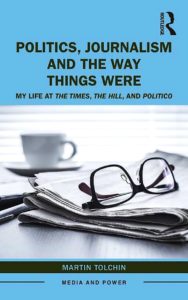 Journalists will enjoy this memoir, but anyone who’s suffered a setback or come face to face with failure will profit and take heart. By looking back on his life, Martin Tolchin (known to everyone as Marty) offers a way forward, and not just for those trying to succeed in journalism.
Journalists will enjoy this memoir, but anyone who’s suffered a setback or come face to face with failure will profit and take heart. By looking back on his life, Martin Tolchin (known to everyone as Marty) offers a way forward, and not just for those trying to succeed in journalism.
He shows that what it takes to survive and thrive in any profession is courage, which, Winston Churchill said, “is rightly esteemed the first of human qualities … because it is the quality which guarantees all others.”
Tochin begins his book, Politics, Journalism, and the Way Things Were: My Life at the Times, the Hill, and Politico, at the beginning, growing up in the Bronx, the only child of progressive parents. Not quite a red-diaper baby, he was enough to the left that he joined a Marxist study group at the Bronx High School of Science.
This — plus attending a Pete Seeger concert and receiving a pamphlet from Katharine Hepburn that began, “I speak because I am an American” — was enough to mark him as a “subversive” during the McCarthy era.
With self-deprecating humor, he writes: “I graduated from Bronx Science by the skin of my teeth.” He had no chance to enroll at an elite East Coast university. “My college adviser said, ‘We’ll start in Colorado and work our way west.’ That’s how I ended up at the University of Utah in Salt Lake City after a short stint at Idaho State College in Pocatello.”
Following college and law school, he joined the Army, but as a “subversive” he could not practice law unless he named the names of those in his Marxist high school study group. He refused. “So three years of law school went down the drain,” he writes.
In addition, he was given only a general discharge, which marked him for years, until the Supreme Court struck down the Army’s policy of withholding honorable discharges for political activities prior to induction.
Yet there are no bitter recriminations in Tolchin’s narrative, which is suffused with gentle humor, including the time he was in the Army and crept into a darkened Carnegie Hall late one night with a date. Spotting the piano in the middle of the empty stage, he began playing, and the maintenance men, enchanted, began lighting the hall tier by tier.
“When I finished they applauded. I think my uniform prompted their kindness, but the fact is I’ve played Carnegie Hall,” he writes.
After his Army stint, unable to practice law, Tolchin took a two-day course offered by the Veterans Administration titled “How to Get a Job.” He shares the wisdom he learned: First, decide what you enjoy doing; if you do what you love, you’ll never regret working. Then, write no fewer than 100 CEOs of the companies that do the work you want, offering to work in any capacity as long as there’s room for advancement. Then, initiate — don’t respond — by saying: “May I call your office on (date) to ask for an appointment.”
Tolchin wrote 110 such letters. One of the four responses he received was from the New York Times, where he started as a 25-year-old copyboy. Looking for stories to write, he haunted laundries, churches, police stations and restaurants, always asking: “What’s everybody so upset about in the neighborhood?” Inevitably, he got a good story.
After chasing cops and cons, he landed on the women’s page writing features. Lured to the newsroom, he could not write under deadline, he admits. So the Times put him on “night rewrite” from 7 p.m. to 3 a.m., and within 18 months he was writing 1,000 words an hour.
Tolchin worked for the paper for 40 years, covering the good and the great. After retiring as a White House correspondent, he started The Hill as a weekly newspaper; it now operates as a U.S. website. Then, at 76, he helped launch Politico, now a global website. Finally, at 92, he’s decided to retire … “for the time being.”
His is a thoroughly delightful book by a writer who puts the smile in likability. My only carp is with the publisher’s presentation — a skimpy paperback with tiny type, squeezed margins and no photo gallery. It’s like giving someone a cashmere sweater in a sack. The package is unworthy of the present.
Tolchin’s book deserves to take its place in the pantheon of journalistic memoirs with Growing Up by Russell Baker, My Life and the Times by Turner Catledge, Personal History by Katharine Graham, A Child of the Century by Ben Hecht, Letters to the Nation by Molly Ivins and by Jeannette Walls.
Given the sorry statistics facing journalism today, one wonders about the future of that pantheon, considering the Gallup poll Tolchin cites that shows Americans’ trust in journalism has fallen since 1976, when it was at an all-time high of 76 percent, to an all-time low of 32 percent.
Tolchin doesn’t analyze what happened in those four decades to cause Americans to lose trust in the media, but he reports an eye-popping political cleavage: the level of trust in the press is 76 percent for Democrats, 42 percent for Independents and 21 percent for Republicans.
Despite these sorry statistics, Tolchin remains an optimist, and in the classes he teaches he encourages students to pursue journalism. “If you’re interested in people and ideas, enjoy constantly learning and want to have an impact on your community, nation and the world, you should seriously consider a career in journalism. It’s given me a great ride.”
The same can be said for his book.
Originally published in Georgetowner March 11, 2020
The Lost Diary of M
by Kitty Kelley
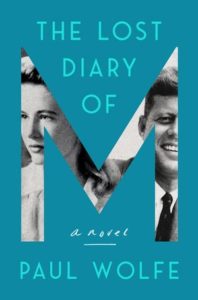 Many intriguing stories spring from the “what if” crevices of a writer’s imagination to conjoin fact and fiction, which is how Paul Wolfe came to write his second novel, The Lost Diary of M.
Many intriguing stories spring from the “what if” crevices of a writer’s imagination to conjoin fact and fiction, which is how Paul Wolfe came to write his second novel, The Lost Diary of M.
“M” refers to the ex-wife of CIA operative Cord Meyer, Mary Pinchot Meyer, the artist who had an affair with John F. Kennedy in the White House. Months after the president’s assassination, Mary was mysteriously murdered in broad daylight while walking along the C&O Canal in Georgetown. The accused assailant was found not guilty.
“The lost diary” refers to the journal Mary kept, which was found after her death by her sister, Tony Bradlee, then married to Ben Bradlee, later executive editor of the Washington Post. Tony turned her sister’s journal over to their friend James Jesus Angleton, CIA chief of counterintelligence. The diary was never seen again, nor its contents ever revealed.
Given those established facts and a cast of real characters, Wolfe takes off in the voice of Mary, who, according to public record, was an LSD disciple of Timothy Leary who shared drugs with JFK. Enter here the fictional fantasies of “what if.”
What if Mary’s diary was not destroyed? What if it reveals her life as an ex-CIA wife? “I learned the secrets of codes and agents and networks and interrogations.” What if her diary contains all that JFK confided about the Bay of Pigs fiasco and the Cuban Missile Crisis? What if she discovers the CIA plot to assassinate Kennedy — she refers to the Warren Commission and its finding of one lone gunman as “Fictions from an Assassination.”
What if Mary storms a society ball in Washington and boldly confronts her former husband with evidence of his agency’s perfidy? What if that revelation eventually leads to her killing? What if her diary reveals her preposterous plan for world peace by having her circle of Georgetown wives give their powerful husbands LSD to lead them to “cellular evolution,” which moves them to see the folly of their power-seeking ways, and — voila! — they end the Cold War?
(I use the word “preposterous” for this fictional fantasy which Wolfe labels “Chantilly Lace,” but it’s probably no less harebrained than the actual CIA plan to assassinate Fidel Castro with an exploding cigar and, failing that, poison pills hidden in a cold cream jar.)
The challenge in writing a novel based on real people and events is making the nonfiction details so accurate that readers will accept the creative leaps. For the most part, Wolfe succeeds. One glaring exception, however, occurs when he has JFK saying to Mary that “the arc of the moral universe is long, but it bends towards justice.” That iconic phrase belonged to Martin Luther King Jr. Its placement in the novel is particularly jarring when Mary tells readers: “Then he asks me to bend toward justice and nudges the back of my neck.”
Wolfe weaves his facts and fictions so tightly, you might need Google to see if John Foster Dulles, Eisenhower’s secretary of state, and his brother, CIA director Allen Dulles, really did have “intimate business dealings with Hitler’s pals.” (They did.)
Did the British spy Kim Philby defect to the Soviet Union because he had a German mistress there, whom he later married? (He did.) Was there really an Operation Midnight Climax run by the CIA that financed bordellos and sent drug-addicted prostitutes to pick up men late at night, bring them back, and ply them with LSD-laced drinks so that agents watching behind a hidden screen could monitor the drug’s effects? (There was — and they did.)
Having hoovered the JFK oeuvre, which, according to Wikipedia, now numbers 1,000-2,000 books, Wolfe illuminates his characters with telling details: Kennedy’s “back brace,” Mary’s “unshaven arm pits.” He nails the columnist Joseph (“Joe”) Wright Alsop V as an effete snob who refuses to dine in a Paris restaurant if the wine cellar is too close to the Metro. Alsop maintains the vibrations of the train will disturb the sediment in the bottles.
Wolfe writes with grace, and many of his sentences sparkle: “The words of Ted Sorenson, the devout Unitarian, the megaphone of Jack’s mind, a poet of politics.”
So much of The Lost Diary of M will ring true to those who’ve followed the comet of Camelot, or who lived in Washington during the days when J. Edgar Hoover ran the FBI and sent his agents to hire out as waiters and bartenders to listen for gossip. One hostess confides: “The best pastry chef I ever employed turned out to be an FBI agent.” Seems comical in the age of A.I., when Alexa outperforms Mata Hari, but that was the 60s.
Kennedy aficionados and conspiracy theorists will enjoy a thumping good read and appreciate Paul Wolfe’s prodigious research, while journalists may note with interest his mention of Ben Bradlee in the author’s note, and how he questions Bradlee’s “tortuous half-century of conflicting and contradictory narratives about his ex-sister-in-law, Mary Pinchot Meyer, and his denials of his own CIA affiliations.”
What if…this is a clue to Wolfe’s next novel?
What if…Wolfe writes about a revered newspaper editor with agency connections who is driven to…
What if?
Crossposted with Washington Independent Review of Books
The Club Savors “This Is Happiness”
by Kitty Kelley
 “I loved reading This is Happiness by Niall Williams because, in our current political turmoil, I appreciated being taken back to the soft ringing of bells in Ireland and the escape to an eccentric little town as enchanting as Brigadoon,” said Sarah Gorman, the book club captain. Noting that the biggest problem the residents faced was the arrival of the electrical grid, she said she found the book a sheer delight — “despite all the rain.”
“I loved reading This is Happiness by Niall Williams because, in our current political turmoil, I appreciated being taken back to the soft ringing of bells in Ireland and the escape to an eccentric little town as enchanting as Brigadoon,” said Sarah Gorman, the book club captain. Noting that the biggest problem the residents faced was the arrival of the electrical grid, she said she found the book a sheer delight — “despite all the rain.”
The group laughed recounting all of the book’s numerous raps and rhapsodies about rain. “It was either sleeting or sprinkling or pouring or pinging or soaking or misting,” said Carey Rivers, who mentioned that Williams’s previous novel, History of the Rain, had been long-listed for the Man Booker Prize in 2014.
“Well, you probably couldn’t have a novel about Ireland without a little rain,” said Stephanie deSiboar, who had chosen the title and hosted the club’s monthly dinner. “I admit the rain must’ve been oppressive, but I became so involved with the story I felt like I was living in Faha [the fictional town in County Clare].” She said she finished reading the book in two days.
Others said they took longer because the narrative pace was slow — “so very, very slow,” said Laura Rivers, a paintings conservator with the J. Paul Getty Museum in Los Angeles, who had flown in to spend the holiday weekend with her mother. “So slow I still haven’t finished it.”
“The language was just too luxurious to rush,” said Kit Krents, recently retired administrative director of law firm Cleary Gottlieb. “I savored every sentence and can’t remember a story that has moved me as much. But, be cautioned,” she added, “you can’t pick up this book if you’re in a hurry and want a fast read.”
Susan Burrows, a law library professional, agreed. “The writing is so lush that I began reading paragraphs out loud to my husband. Drove him crazy, but the words are so rich, the language so luscious, that I just had to share them.”
“The characters in this book are not looking for change, which disturbs things and upsets their routines. They’re happy as they are,” said Gorman. “Hence the title.” The verdict that evening was a unanimous rave for This Is Happiness, the story of an old man looking back on his youth as an orphan. Having left the priesthood and gone to live with his grandparents in an Irish town that time had almost forgotten (until the arrival of electricity), he’s writing out his memories “because at the end we all go back to the beginning.”
His look backwards forms the loose plot of the book, which all agreed is carried by strong writing and vivid characterization; this is a book club that prizes fine writing.
“In fiction, most of our choices are Man Booker prizewinners or runners-up,” said deSiboar. “We don’t read sci-fi or mysteries or fantasies.”
“In nonfiction, we’ve tended recently to World War II authors like Erik Larson and Lynne Olson,” said Rivers, “but …
Before she finishes her sentence, the group begins listing their favorite books over the years. They collectively attempt to come up with their top five, using A Gentleman in Moscow, a 2016 novel by Amor Towles, as their gold standard.
Everyone agrees the list should include Barbara Kingsolver’s 1998 novel The Poisonwood Bible, Donna Tartt’s The Goldfinch of 2013 and Christine Sutherland’s 1984 historical work The Princess of Siberia. “That’s got to be in the top 100 books of all time,” said the captain.
But then the group diverges, offering a literate inventory that includes the 2015 novel A Little Life by Hanya Yanagihara, Viktor Frankl’s 1946 Man’s Search for Meaning, the 2011 novel The Sense of an Ending by Julian Barnes and Wallace Stegner’s Angle of Repose and Crossing to Safety, from 1971 and 1987, respectively.
By 9 p.m., the captain announces the hardest part of the evening, which, she explains, is selecting the next book to read: “The choice usually goes to whoever shouts the loudest.”

Originally published in The Georgetowner February 26, 2020
In the Land of Men
by Kitty Kelley
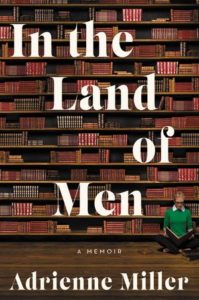 Adrienne Miller does not mince words when she dictates the duty of book reviewers: “The reviewer’s job is to evaluate the book on its own terms and to determine how well the book succeeds — or doesn’t — within those terms.”
Adrienne Miller does not mince words when she dictates the duty of book reviewers: “The reviewer’s job is to evaluate the book on its own terms and to determine how well the book succeeds — or doesn’t — within those terms.”
So informed, I cautiously offer what will become obvious while reading In the Land of Men — Miller, 47, writes with daunting authority and suffers no lack of self-confidence.
Growing up in Marysville, Ohio, as the only child of “permissive” parents, she writes that as a youngster she was extolled for “my quiet intelligence.” Academically gifted, she recalls her “Jamesian moment” (I presume that’s Henry, not Jesse) as seeing “Amadeus” eight times when she was 13. That Milos Forman film, plus an “enduring obsession” with Thomas Jefferson, formed the landscape of her adolescence: “I was an odd child.”
Her family moved to Akron when she was 9. There:
“The sunsets, at first, before I finally started paying attention, didn’t seem as striated or as luminous as they had back in the flatness of Marysville, and new categories of precipitation fell from the sullen, but possibly more interesting, northeast Ohio sky.”
Following college “at a Midwestern no-name university” and a couple of go-fer years at GQ, her “quiet intelligence” made noise. She put herself forward to become the literary editor of Esquire at the age of 25, and, she writes, she was fully entitled to the position. “It’s not as if one can earn a Ph.D. in ‘literary editor.’ Instinct, taste and judgment can’t be taught. And I knew I had instinct, taste and judgment. I was my own first choice, and that’s all that mattered.”
She held the job for eight years, beguiled by Esquire as “the chief platform for American short fiction from the forties through the seventies: Norman Mailer, Raymond Carver, Saul Bellow, William Faulkner, Tim O’Brien, F. Scott Fitzgerald, Dylan Thomas and Ernest Hemingway.” Not a woman in the bunch; hence, the title In the Land of Men.
Her publisher is positioning her memoir as a feminist wail from the male trenches. But, while Miller blasts some unnamed men for sexual assaults, her book is actually a knee-bending homage to one particular man who dominates every page: David Foster Wallace, the 46-year-old writer destroyed by his demons; he committed suicide in 2008.
“[H]is artistic triumph in the face of such tremendous psychological and emotional odds was a miracle for which we all must be forever grateful,” she writes. She reveres Wallace for writing Infinite Jest, which Time listed as one of the 100 best English-language novels published between 1923 and 2005.
Miller sanctifies his thousand-plus-page book as “the novel that had changed the world,” and “changed our language.” She ranks it alongside the universe-bending genius of the pyramids, Beethoven’s Ninth, and Chartres Cathedral.
Besotted by Wallace, Miller edited four of his short stories for Esquire. “He was the fiction writer with whom I’d work the most frequently at the magazine.” She moved quickly from being his editor to his lover, noting “the relationship fast-trackiness” of their affair:
“There was a sense that David, more than any other living writer, was read compulsively, his sui-generis-ness unbearable to all…[It] is true that I regarded David not merely as a great writer but as one of the greatest and most uncompromising artists of all time.”
She rhapsodizes about “so radically name-y a name: David Foster Wallace.” She recalls every item he carried in his canvas bag, and all they discussed over their first lunch. She relates detail after detail of their decades-old telephone conversations — whether preserved in a diary, tape recordings, or fevered memory, she doesn’t say.
“I looked at David. David looked at me. His eyes were a rich chestnut flecked with gold.” Oh, dear. A bit too Barbara Cartland-y here, but it’s a rare lapse in an otherwise literary-soaked tribute to one man’s memory.
“David was Augustinian,” Miller writes, which may send you to Google to try to figure out the connection between the 5th-century bishop of Hippo, whose prolific writings influenced all of Western Christianity, and Wallace, who wrote two novels, three collections of short stories, two books of essays, and several magazine articles.
In the Land of Men proves that Miller has read widely and deeply. She cites Tate, celebrates Nabokov, quotes Pindar, genuflects to Mozart, and even begins a dialectic on the virtuosic talent of John Barth.
She commands an astonishing vocabulary, too: “the rhizomatic conversations”; “an anvilesque collection”; “a self-serving sockdolager of rage.” Throughout the book, she employs an eccentric style that would give Strunk and White the bends, adding “y” to words for no fathomable purpose: “workshop-y,” “science-y,” “kind of date-y,” “magazines were so interminably magazine-y,” “a self-help-y version,” “ugly and rape-y.”
For the most part, though, she makes magic on the page. She describes the 24/7 “Jackie deathwatch” outside Kennedy Onassis’ Fifth Avenue apartment as “a stream of people united in one brow of woe.” Some of Miller’s literary references sent me scrambling to the Internet, such as when she was once made to wait at a stage door for Wallace and “felt preposterously like the Person of Consequence in Gogol’s ‘The Overcoat’: Do you know to whom you are speaking?”
Minutes later, she sees “some Fanilow-type people were waiting for him on the sidewalk.” (If you’re a child of the seventies, you’ll know she’s referring to the fans of Barry Manilow. If not, you’ll run to the Urban Dictionary.)
She dismisses a high-school classmate as “Charles Bukowski, but on paint thinner.” (Of course, you know that Bukowski, who died in 1994, was a German-born poet who celebrated prostitutes and drug addicts.)
If you’re a devotee of David Foster Wallace, you’ll devour this memoir with pleasure. If not, you may enjoy the cultural scavenger hunt and appreciate how much Adrienne Miller makes you stretch. After all, as Robert Browning wrote, “A man’s reach should exceed his grasp, or what’s a heaven for?”
Crossposted with Washington Independent Review of Books
The Age of Entitlement
by Kitty Kelley
 In the 18th century, the Age of Enlightenment illuminated the world of ideas throughout Europe, stretching as far as America, where Thomas Jefferson adopted some of its ideals when writing the Declaration of Independence. Perhaps Christopher Caldwell aspired to achieve similar status by calling his book The Age of Entitlement.
In the 18th century, the Age of Enlightenment illuminated the world of ideas throughout Europe, stretching as far as America, where Thomas Jefferson adopted some of its ideals when writing the Declaration of Independence. Perhaps Christopher Caldwell aspired to achieve similar status by calling his book The Age of Entitlement.
In it, he explores the last five decades of a U.S. cultural upheaval spurred, he claims, by the Civil Rights Act of 1964 and the Voting Rights Act of 1965, legislation he sees as “a model for overthrowing every tradition of American life.”
Caldwell’s revolution starts with the assassination of John F. Kennedy in 1963, the event that propelled JFK’s successor, Lyndon B. Johnson, to initiate Civil Rights legislation. “[This] ideology, especially when it hardened into a body of legislation, became, most unexpectedly, the model for an entire new system of constantly churning political reform.”
With facile writing and impressive research, Caldwell examines his premise in detail, hitting the era’s hot-button issues: abortion, affirmative action, busing, Robert Bork, Gloria Steinem, women’s rights, and gay marriage. He divides his book into seven sections: race, sex, war, debt, diversity, winners (African Americans, women, and gays), and losers (white men).
Each of these sections contains bite-size subsections arguing aspects of Caldwell’s premise that “civil rights had been sold to the American public” under false pretenses, causing incalculable wreckage to society:
“The new system for overthrowing the traditions that hindered black people became the model for overthrowing every tradition in American life, starting with the roles of men and women.”
As a conservative, white, male graduate of Harvard, Caldwell writes to the right, occasionally to the left, and sometimes swerves center as he cites lawsuit after lawsuit to make his points, one of which actually suggests that maybe Southern segregationists were correct all along.
His book, which relies on much of the conservative journalism he’s published in the Financial Times, the National Review, and the Weekly Standard, reads like the lamentation of an anguished man who sees his world slowly crumbling beneath him.
Not all conservatives will applaud, particularly those who marched in the Reagan revolution. For Caldwell lambasts Ronald Reagan on the issue of “mass immigration,” which, he maintains, “stands perhaps as [the president’s] emblematic failure. Reagan threw open the floodgates to international immigration while stirringly proclaiming a determination to slam them shut. Almost all of Reaganism was like that.”
What Caldwell grieves, progressives might celebrate, even the messiness of change and the discomfort of adjustment. He rails against political correctness, considers it an affront to have to call black people African Americans, and resents the federal holiday dedicated to Martin Luther King Jr.
He lambasts his alma mater for ruling in 2016 that professors presiding over Harvard’s undergraduate houses be called “faculty deans” rather than “house masters,” sarcastically wondering if “kids would be unable to distinguish their house master from a slave-driving antebellum overseer.” Strange that a skilled writer like Caldwell, who lives by the power of words, can’t acknowledge the degree of civility Harvard conferred with its small change.
The author becomes particularly overheated when he claims that, by embracing political correctness, Americans have “inadvertently voted themselves a second constitution,” and it’s this second constitution, with its P.C. laws, “nurtured by elites in all walks of life,” that currently prevails. He ridicules diversity as if it’s nothing more than a Mercedes Benz, “a marker of money, class, and power.”
He even chides CNN founder Ted Turner for ordering his company’s personnel to refer to things outside the U.S. as “international” rather than “foreign,” ignoring that “international” suggests a broader, more cosmopolitan embrace than “foreign,” which conjures all things strange, unfamiliar, and alien. (That last sentence probably consigns me to the P.C. circle of hell.)
While much of this provocative book — with its conservative critique of the last 55 years in America — is interesting, it never rises above the author’s anger or overcomes his fury with the people of color, women, and gays who’ve challenged the system and won the changes that have rattled Caldwell’s world. He vents his spleen at a society that is not standing still and remaining soldered to tradition, but, in his view, is descending into chaos and leaving white men grasping the shreds of what once was.
More polemic than panacea, The Age of Entitlement is one man’s screed against change. As such, it offers no soothing balm to the gloom it delivers.
Crossposted with Washington Independent Review of Books
The American Story
by Kitty Kelley
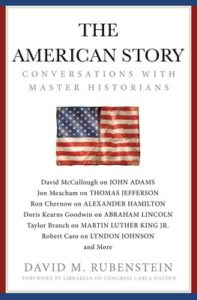 For those who love history and enjoy biography, David M. Rubenstein has delivered a masterstroke with The American Story, in which he presents his interviews with authors of notable biographies. Among them are David McCullough on John Adams; Ron Chernow on Alexander Hamilton; Taylor Branch on Martin Luther King Jr.; Walter Isaacson on Benjamin Franklin; Robert Caro on Lyndon Johnson; and Doris Kearns Goodwin on Abraham Lincoln.
For those who love history and enjoy biography, David M. Rubenstein has delivered a masterstroke with The American Story, in which he presents his interviews with authors of notable biographies. Among them are David McCullough on John Adams; Ron Chernow on Alexander Hamilton; Taylor Branch on Martin Luther King Jr.; Walter Isaacson on Benjamin Franklin; Robert Caro on Lyndon Johnson; and Doris Kearns Goodwin on Abraham Lincoln.
In total, The American Story is a delectable smorgasbord of U.S. history, covering 39 books discussed by 15 authors, some of whom have written more than one biography.
The American Story grew from an idea Rubenstein proposed in 2013 to present a dinner series for members of Congress entitled “Congressional Dialogues,” in which he would interview acclaimed historians in the gilded setting of the Library of Congress.
He said his purpose was to educate public servants, “to provide the members with more information about the great leaders and events in our country’s past, with the hope that, in exercising their various responsibilities, our senators and representatives would be more knowledgeable about history and what it can teach us about future challenges.”
He also hoped that bringing the members together in a nonpartisan setting might reduce the rancor in Washington. Six years later, he admits the jury is out on the former and that absolutely no traction has been gained on the latter.
Rubenstein, who made his fortune ($3.6 billion) in private equity as co-founder of the Carlyle Group, styles himself as a “patriotic philanthropist,” having purchased the last privately owned original Magna Carta for $21.3 million and then loaning it to the National Archives.
In addition, he has given $7.5 million to repair the Washington Monument; $13.5 million to the National Archives for a new gallery; $20 million to the Thomas Jefferson Foundation; and $10 million to Montpelier to renovate James Madison’s home. So, when the “patriotic philanthropist” asked to host his own interviews at the Library of Congress, the answer was, quite sensibly, yes.
Yet Rubenstein brings more than his b-for-boy-billions to this book. He has delved deeply into American history, having read at least one biography of each president and “every single biography” about John F. Kennedy, the commander-in-chief with whom he feels the greatest connection.
He has donated millions to the John F. Kennedy Presidential Library and Museum in Boston, the Kennedy School of Government at Harvard, and the John F. Kennedy Center for the Performing Arts in Washington, DC, where he serves as chairman of the board of trustees. He recently contributed $50 million for the Kennedy Center’s REACH expansion, upon which his name is chiseled in marble.
As much as Rubenstein admires our 35th president, however, his interview with biographer Richard Reeves (President Kennedy: Profile of Power) shows some of the dark side of JFK’s reign, including the assassination of Rafael Trujillo, the dictator of the Dominican Republic, and the attempted assassination of Fidel Castro.
Some readers will be startled to learn that JFK knew in advance about the Berlin Wall (“for which he was practically a co-contractor,” says Reeves) and had, in effect, consented to building it to protect the small U.S. force of 15,000 soldiers in West Germany from the hundreds of thousands of Russian soldiers on the eastern side.
The American Story shows almost every president to have had a flaw that scarred his legacy: FDR turned away Jewish refugees, sending them back to sure death under Hitler; JFK misfired on the Bay of Pigs; Richard Nixon resigned over Watergate; Vietnam doomed Lyndon Johnson; and, with the exception of John Adams, all the Founding Fathers owned slaves. Yet, as Walter Isaacson put it so well, “The Founders were the best team ever fielded.”
In mining nuggets of history, Jean Edward Smith (Eisenhower in War and Peace) reveals that D-Day might have failed had Hitler not been sleeping. His best Panzer tank troops were available to repel the invading Allies, but only he could give the order to use them, and no one dared wake the Führer during the initial hours of the landing. By the time he woke up, the Normandy beachheads had been secured.
Did the Allies know Hitler had orders not to be disturbed while sleeping? Or was it a matter of the great good luck that Smith said accompanied Eisenhower throughout his life?
Early in his career, Ike was almost court-martialed for claiming his son on his housing allowance for $250 (valued at $3,000 in 2017) even though his son was not living with him. Gen. John J. Pershing got the charge reduced to a letter of reprimand, and Eisenhower soared to a glorious career as a five-star general.
The Q&A format of this book is ingenious. Rubenstein, who’s mastered his subject matter, asks informed questions that stimulate impressive responses, and the “patriotic philanthropist” is not above probing into the personal and provocative:
About Benjamin Franklin: “He seemed to have a lot of girl friends.”
About Alexander Hamilton: “He had a bit of an amorous reputation. In fact, what did Martha Washington call her tomcat?”
About Dwight Eisenhower: “He was the only [WWII] general who may have had [an affair with] his ‘driver.’ Is that right?”
About Ronald Reagan: “Did he dye his hair?”
Rubenstein’s most engaging interview, with U.S. Supreme Court chief justice John G. Roberts Jr., comes at the end of the book. Roberts studied history as an undergrad at Harvard with hopes to make it his career, but then changed his mind.
“I was driving back to school from Logan Airport in Boston one day and I talked to the cabdriver. I said, ‘I’m a history major at Harvard.’ And he said, ‘I was a history major at Harvard…’ [After that] I thought I would move to law.”
Rubenstein, also a lawyer, responds: “In the first year of law school — really in the first month or two — you realize certain people have the ability to quickly do legal reasoning. They have the knack of it, and some people don’t. You must have realized that it wasn’t as hard as you had thought it would be.”
Smart as Rubenstein is, you have to love Roberts, who graduated cum laude from Harvard Law School: “It was as hard as I thought it would be. It was pretty hard throughout.”
The American Story is a creative concept that delivers delicious bite-size bits of American history to those who haven’t had the time or inclination to read widely. I devoured every page with immense pleasure.
Crossposted with Washington Independent Review of Books
She Said
by Kitty Kelley
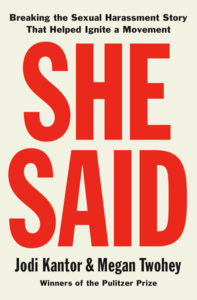 She Said: Breaking the Sexual Harassment Story that Helped Ignite a Movement by Jodi Kantor and Megan Twohey landed with its red title blazing like lipstick smeared on the cracked mirror of a truck stop. Yet, as much as I respect the two New York Times, Pulitzer Prize-winning reporters who bolstered and tracked the #MeToo movement, I hesitated opening their book.
She Said: Breaking the Sexual Harassment Story that Helped Ignite a Movement by Jodi Kantor and Megan Twohey landed with its red title blazing like lipstick smeared on the cracked mirror of a truck stop. Yet, as much as I respect the two New York Times, Pulitzer Prize-winning reporters who bolstered and tracked the #MeToo movement, I hesitated opening their book.
Having watched the bruising Brett Kavanagh hearings, plus nonstop coverage of the sexual plunders of Donald Trump and Harvey Weinstein, I didn’t think I could stomach one more word about their depravities.
In addition, I’d read Ronan Farrow’s three-part series in the New Yorker about Black Cube, the private Israeli investigation firm hired by Weinstein’s lawyer, David Boies, to dig up dirt on Weinstein’s accusers, itself serialized in Farrow’s book Catch and Kill: Lies, Spies, and a Conspiracy to Protect Predators. This came on the heels of James B. Stewart’s excellent reportage in Deep State: Trump, the FBI, and the Rule of Law.
What more did I need to know about the fetid pathology of men hell-bent on sexually abusing women?
The answer lies in Kantor and Twohey’s spectacular book, which takes its title from the futile disputes of “he said, she said,” where there’s no corroborating evidence for either side and, consequently, no bona-fide winner. In point of fact, the winner is usually “he,” and the loser “she,” because “she” has no leverage in the powerful world of “he.”
That finally may be changing, thanks in large part to these investigative journalists, who devoted two years to giving abused women — 80 to date — a voice, helping them crawl out of the emotional cages where most had been cowering, terrified of their powerful predator.
The book provides a platinum primer on investigative reporting as Kantor and Twohey take readers inside their responsible march to publication: It’s a tale of lawyers who vet, editors who edit, and researchers who check and re-check facts while the reporters write and rewrite and rewrite again.
They spend days, weeks, and months searching for contact information — finding relatives, friends, neighbors, and work associates to lead to sources who, initially, balk at being contacted. A few agree to talk off the record but refuse to be quoted by name for fear of retaliation.
After years of terrified silence, most of the women who had lost or left jobs with career hopes dashed — especially those who had signed non-disclosure agreements — saw nothing to be gained by speaking out:
“Actresses, prominent and unknown, had told reporters Weinstein stories and sworn them to secrecy. The pattern that had protected Weinstein for decades — no actress wanted to be the one to speak up and name him — still held.”
Just like cowboys in old TV Westerns: Everyone wanted cover.
Perhaps being women themselves, the two journalists understood why so many victims felt they were somehow at fault for being assaulted by Weinstein. With sensitivity, Kantor and Twohey did not push; they listened quietly, responded gently. “I can’t change what happened to you in the past,” each said, “but together we may be able to use your experience to help protect other people.” Finally, they earned the trust they needed to pursue the story.
That’s when the saga becomes frightening, with dark, back-alley skulks.
Black Cube begins a campaign to intimidate the reporters, trying to push them off their story. The reporters start receiving strange emails and texts from an actor-agent identifying herself as being from an organization in London who wants to talk about gender equality in the corporate sphere. Their executive editor at the Times, Dean Baquet, warns them to assume their communications are being monitored, their tracks followed.
In a sweet aside, the reporters mention a detail about their editor, who insisted their investigation be irreproachable. He had told them that, at the start of his newspaper career, he’d written about a small-time actor who posed as a talent scout to lure aspiring actresses as young as 14 into private meetings and then raped them. Baquet felt his “sensationalized and melodramatic” stories convicted the man in print without a fair defense. “I always felt like everyone in the courtroom lost a little respect for me, including the prosecution.”
Including that story reflects well on the reporters, and more so on their boss, who gives new meaning to Shakespeare’s observation: “They say best men are molded out of faults, and, for the most, become much more better for being a little bad.”
Following Baquet’s lead, Kantor and Twohey low-key everything, even the most lurid details of their investigation. They write with restraint about Weinstein’s young female assistant tasked with procuring and organizing his “personal supply of an erectile dysfunction drug called Caverject, administered through injection into the penis…[She] had to keep a supply of those shots at her desk, hand them off to him in brown paper bags, and sometimes run the drugs to hotels and elsewhere, just before his meetings with women.”
Threads of the Weinstein story had appeared in the New York Times since 2017, but not with the full wallop of this book, which reads like a John le Carré thriller, detailing egregious crimes, a tangled web of clues, frightened witnesses, cover-ups, bribes, threats, double-dealing lawyers, and cash payments in exchange for non-disclosure agreements. She Said makes All the President’s Men look like “Mary Had a Little Lamb.”
When David Boies, who charges $2,000 an hour to be David Boies, tells the reporters he was “unaware” of the Black Cube tactics used against them, you may roll your eyes; when he adds his regret for not paying closer attention, you’ll want to throw up.
But there’s a comeuppance: Because the law firm of Boies Schiller Flexner also represented the Times on certain matters, when the newspaper learned of Boies’ actions, which they deemed “reprehensible,” they fired the firm for “grave betrayal.”
Boies then threw Weinstein, his Hollywood red carpet friend and client of many years, under the bus. Maybe Dick the Butcher was right. “The first thing we do,” he said in Henry VI, “let’s kill all the lawyers.”
Weinstein shrewdly surrounded himself with a highly credentialed crew of female attorneys to protect him, including Linda Fairstein, once renowned in the field of sex-crimes prosecution, and Lisa Bloom, who, upon publication of this book, should’ve packed a go bag and headed for the Azores, where they might not have read the damning memos she wrote to Weinstein, all reprinted in She Said, all showing her avarice, her appalling lack of scruples and basic legal ethics.
Bloom is the daughter of Gloria Allred, supposed defender of abused women, who hovers at their side on cable television and then takes 40 percent of every settlement she negotiates. Kantor and Twohey report that they “didn’t realize, and would never have suspected, that Allred’s firm was sitting on separate records about Weinstein’s [financial settlements], ones that had never come to the attention of the government or the public.” Bloom better pack a bag for Mom, too.
Then there’s Lanny Davis, Weinstein’s crisis manager, who starts his spin by bragging to the reporters about his close friendship with Hillary Clinton, his classmate from Yale Law School. Kantor and Twohey ask him about the sexual assault allegations against Weinstein, which he paid millions to conceal:
“Do you think that’s normal for men to make so many payoffs?”
“I do,” said Davis very matter-of-factly.
Memo to Bloom: Make that three go bags.
Crossposted with Washington Independent Review of Books
Erosion
by Kitty Kelley
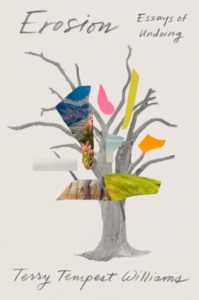 If you’re reading Terry Tempest Williams for the first time, you are meeting an impassioned conservationist who can take her place in the environmental pantheon alongside Rachel Carson, Henry David Thoreau, John Muir, and Rebecca Solnit.
If you’re reading Terry Tempest Williams for the first time, you are meeting an impassioned conservationist who can take her place in the environmental pantheon alongside Rachel Carson, Henry David Thoreau, John Muir, and Rebecca Solnit.
Erosion: Essays of Undoing is her 16th book and, in it, Williams writes of how the world is splintering and crumbling because of those who plunder public lands for oil, gas, and other fossil fuels.
Williams is particularly inflamed about what has happened to two national monuments in her home state of Utah: Bears Ears (1.3 million acres) and Grand Staircase-Escalante (1 million acres). Both had been designated as national monuments by President Obama and thus permanently protected, but months after Donald J. Trump took office, he ordered an 85-percent reduction in federal protections, which opened both areas to private development. She writes:
“The fury to strategically undo decades of environmental regulations and laws passed on behalf of ecological integrity and human health has been unleashed inside the Department of Interior and the Environmental Protection Agency.”
Believing the life of the planet is now at stake, Williams marshals dazzling prose to summon activists to resist and revolt. She believes “to belong to a place and a group of people saves our lives,” and that each of us must fight for salvation, which means waging war against all disrupters of public lands.
From 1987-1992, she engaged in acts of civil disobedience to protest against nuclear testing in the Nevada desert. More recently, she and her husband formed a legal entity to purchase a gas-and-oil lease from the Bureau of Land Management for 1,120 acres near their home in order to keep the resources in the ground forever:
“Our purchase was more or less spontaneous, done with a coyote’s grin, to shine a light on the auctioning away of America’s public lands to extract the very fossil fuels that are warming our planet and pushing us toward climate disaster.”
Their clever ruse made front-page news in the Salt Lake Tribune, and, two weeks later, Williams lost her job at the University of Utah as the Annie Clark Tanner Scholar in the environmental humanities graduate program.
Professionally crushed by the fossil-fuel interests in her state, she excoriates fellow Utahan Orrin Hatch, the longest-serving Republican U.S. Senator in history and one who, for 42 years, championed drilling in his state’s public lands. After reading her case against the 85-year-old politician, one may be relieved to know that he’s now retired.
Williams’ zealotry is understandable considering that atomic testing in Nevada between 1951 and 1962 exposed her and her family to radiation, which, she believes, is the reason so many of them have developed cancer. Nine family members have had to have mastectomies, which prompted her to write an essay in 1991 entitled “The Clan of One-Breasted Women.”
Erosion is not a book you drink in one gulp; you take a few sips and savor the skill of a talented writer who fuses soul to scholarship. For some, the essays will be a conservationist’s creed with too much information about red-winged blackbirds and sand bill cranes, while others will be impressed by the depth and detail of the author’s avian expertise.
I confess a raised eyebrow when I read that “the sage grouse is the most powerful individual in the American west right now,” but after reading page after page about this bird with a spikey fan and golf-ball-size eyes, I found myself rooting for a feathered creature I’d never heard of before.
Williams extols the natural beauty of the Colorado Plateau and the red-rock wilderness of the Four Corners Monument, the quadripoint that connects Arizona, Colorado, New Mexico, and Utah. She pays homage to the Endangered Species Act and schools you in all its dimensions — geological, geographical, and geopolitical. Then she swerves into her personal life and the effects of “erosion” on her evolution into a fierce feminist.
Raised a Mormon in Salt Lake City, Williams rails against that church and its beliefs that proclaim African Americans are not worthy to become priests and indigenous people are Lamanites, cursed and cut off from the Lord. She states that the greatest trauma of living in Utah is “the religiosity of the Mormon patriarchy that says you have no authority to speak — women, Indians, black people, brown people. Gay people, trans people.”
The heart-stopping moment of the book comes toward the end in a searing chapter she entitles “The Erosion of the Body,” which Williams means literally as she recalls her brother’s inability to conquer his addictions and his subsequent suicide.
Sparing no details, she gives us the tick-tock of how he hanged himself, and how she and her surviving brother identified his body, placed sunflower petals on the raw sores of his neck, and then slipped a red-tail hawk feather in one dead hand and an owl feather in the other. She leads us to the crematorium, where she and her younger brother sit for six hours in front of the furnace that burns their brother’s remains.
They never flinch, even when the coroner comes to turn the corpse as one might turn a quesadilla. Waiting for his ashes, which will be released into the wilderness, Williams recalls how, shortly before he took his life, he had told her, “I am eroding.”
At that point, the title of this book, dedicated to her dead brother, takes on its deepest dimension.
Crossposted with Washington Independent Review of Books
Patrimony: A True Story
by Kitty Kelley
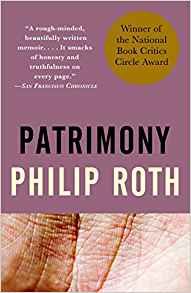 One of life’s toughest journeys is accompanying a loved one into old age or disability, for it is a trip that will inevitably lead to the grave, and that final farewell can bring crushing grief and an awful aloneness.
One of life’s toughest journeys is accompanying a loved one into old age or disability, for it is a trip that will inevitably lead to the grave, and that final farewell can bring crushing grief and an awful aloneness.
In Patrimony: A True Story, published in 1991, Philip Roth made that journey with his 86-year-old father, who had been struck by a virulent brain tumor, leaving him “utterly isolated within a body that had become a terrifying escape-proof enclosure, the holding pen in a slaughterhouse.”
With unsparing prose, Roth chronicles the last two years of his father’s life, which became a horrifying excursion into modern medicine — different doctors with various diagnoses and misdiagnoses, some which required crippling surgeries by men the author “wouldn’t trust to carve my Thanksgiving turkey.”
The questionable results and protracted recovery left father and son bewildered and frustrated as they tried to make wracking decisions about prolonging life and postponing death. In the end, they decide against all surgeries and try to deal with the effects of the growing tumor, which leave Herman Roth disfigured with facial paralysis, deaf in one ear, and blind in one eye.
Through the son, we come to know the father as “obsessively stubborn and stubbornly obsessive,” a “pitiless realist” who tossed out his wife’s clothes hours after she died. Philip Roth’s mother had been “a good-natured, even tempered, untroublesome partner whose faults and failings [his father] could correct unceasingly.”
We see “the poignant abyss” between the pair — the father, two generations removed from Galicia in Northern Spain with only an eighth-grade education, whose hard work as an insurance salesman for Metropolitan Life in Newark made it possible for the son to be educated, the elixir that would elevate him realms beyond his parents — socially, intellectually, and professionally.
“I had prematurely entered high school at the age of twelve, just about the age when [my father] had left for good to support his immigrant parents,” Roth writes.
Obviously gifted, Roth graduated college magna cum laude and was elected to Phi Beta Kappa. Throughout, he felt guilty about outdistancing his father, and reflects that “every course I took and paper I wrote was expanding the mental divide that had been growing wider and wider.”
He earned his M.A. in literature from the University of Chicago, became a Distinguished Professor at Princeton, wrote 32 books of fiction and nonfiction, and won almost every literary prize imaginable.
For many years, Roth distanced himself from his hectoring father, who, he writes, “had no idea just how unproductive, how maddening, even, at times, cruel his admonishing could be.” Yet he pays him loving tribute for being a survivor: for surviving financial setbacks, for surviving an immigrant’s humiliations, for surviving a Jew’s discrimination in the claws of anti-Semitism.
Father and son finally bond over their shared passion for baseball, a bit reminiscent of Field of Dreams. One of the most affecting scenes in the book is Roth’s recollection of game five of the playoffs between the Mets and the Astros on October 14, 1986, when he was in London, six hours away from the game his father is watching in New Jersey.
Their transcontinental conversation sounds like a play-by-play between two exuberant boys until the father remembers his son is calling from England. “Hey…This is going to cost you a fortune.” Ecstatic that his father’s tumor has given him enough remission to enjoy the game, Roth urges him to continue. “Go ahead, Herm. I’m a rich man. Pitch by pitch. Who’s up?”
Roth found his father in advanced age to have become “annoyingly tight” about spending money on himself for a cleaning lady or for a subscription to his beloved New York Times. One wonders why the “rich” son did not step forward to provide those small luxuries, indicating perhaps that the leaf does not fall far from the tree.
Yet, as a good son, Roth stepped up to usher his father through his last 24 months of life, taking care of him as one might a newborn child. He drew his Epsom salt baths, tested the water, helped him in and out of the tub, and observed — only as the author of Portnoy’s Complaint would — that his father’s member “looked pretty serviceable. Stouter around, I noticed, than my own.”
Roth’s writing here is extraordinary but hardly elevating. As the New York Times proclaimed, Patrimony is “American storytelling at its least lyrical.” One of the “least lyrical” parts of this memoir, which won the National Book Critics Circle Award, is the breath-stopping scene of the father’s incontinence in his son’s home, where the old man dissolves into tears and shamefully admits, “I beshat myself.”
The son goes down on his hands and knees, stifling disgust and nausea, to clean a bathroom floor full of his father’s excrement, which, he relates with mordant humor, is true patrimony. “And not because cleaning it up was symbolic of something else, but because it wasn’t, because it was nothing less or more than lived reality.”
Roth saw his patrimony not in inherited wealth or the accumulated treasures of a lifetime from his father, but in cleaning up his father’s befoulment.
On his last day of life, Herman Roth was rushed to the hospital, unable to breathe. The attending physician was prepared to take “extraordinary measures” to keep him alive when Philip Roth arrived and had to decide whether to follow his father’s living will, which stipulated no life support. He writes that he had to sit with his father a very long time before he could say, “Dad, I’m going to have to let you go.”
Only at the end of the book do we learn that “in keeping with the unseemliness of my profession,” Philip Roth had been writing this memoir all the time his father was ill and dying.
Many will be grateful that he did.
Crossposted with Washington Independent Review of Books
